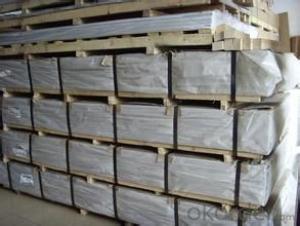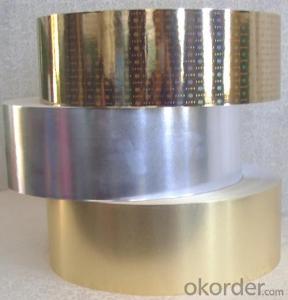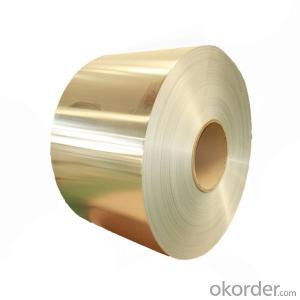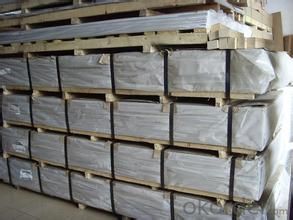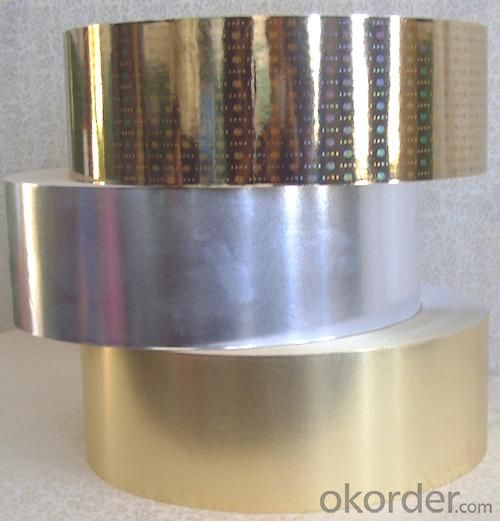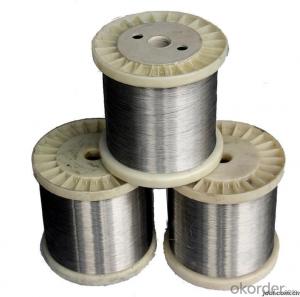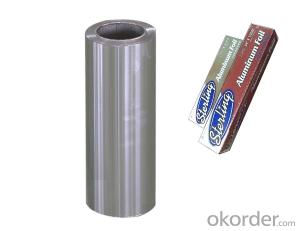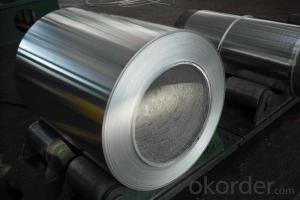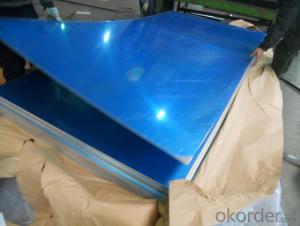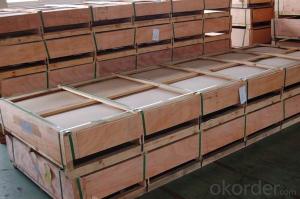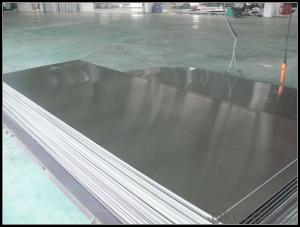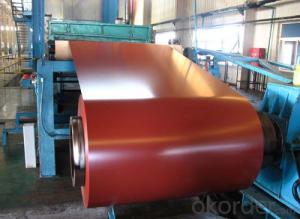1.8mm Brushed Coated Aluminium Sheet
- Loading Port:
- Tianjin
- Payment Terms:
- TT or LC
- Min Order Qty:
- 10 m.t.
- Supply Capability:
- 1000 m.t./month
OKorder Service Pledge
OKorder Financial Service
You Might Also Like
1.Description
Aluminium (or aluminum; see spelling differences) is a chemical element in the boron group with symbol Al and atomic number 13. It is a silvery white, soft, nonmagnetic, ductile metal. Aluminium is the third most abundant element (after oxygen and silicon), and the most abundant metal in the Earth's crust. It makes up about 8% by weight of the Earth's solid surface.
2.Our advantage
Our quality best, service best, price better!
3.Specification and application
Alunimiun Sheet
ALLOY: AA1*** (AA1050,AA1060,AA1070,AA1100 etc.)
AA3*** (AA3003,AA3004,AA3005,AA3105 etc.)
AA5*** (AA5052,AA5083,AA5754 etc)
AA8*** (AA8011,AA8006 etc)
TEMPER: H14,H16,H18,H22,H24,H26,H32,O/F
THICKNESS: 0.2mm-100mm
WIDTH: 30mm-1700mm
STANDARD: GB/T 3880-2006
Special specification is available on customer's requirement
SURFACE QUALITY: GOOD APPEARANCE WITH NO-CRACK AND WELL-DISTRIBUTE GRAIN.
BUILD UP: TIGHT SLIT EDGES FREE FROM CRACKS, LAYER TO LAYER SHIFT NOT MORE THAN 2MM.
PROFILE: -0/+1%
FLATNESS: MILL FLATNESS COIL HAVING EDGE WAVINESS RATHER THAN CENTER BUCKLES SHALL BE ACCEPTABLE.
ROLLING PERFORMANCE: RE-ROLLABLE TO THE FINAL DESIRES GAUGES
4.Pictures
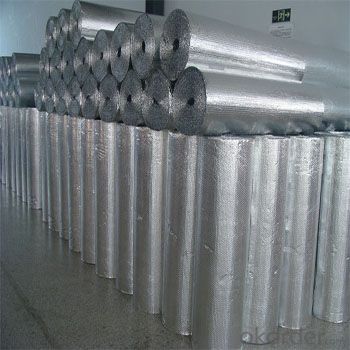

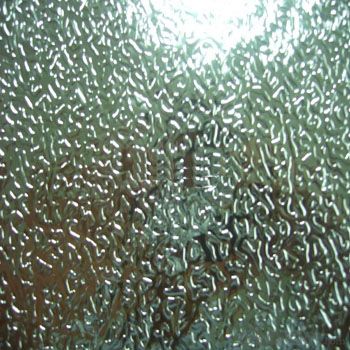

5.FAQ
1)Can we supply samples?
Yes, we can!
2)What can you do if you have other quastions?
You can contact us freely at any time!
Construction is one of the three major markets of aluminum sheets, about 20% of the world's total output of aluminum for the construction industry, a number of aluminum constructions in industrial countries, the amount of aluminum accounts for more than 30% of its total production. In recent years, aluminum construction products constantly updated, color aluminum, aluminum composite, composite door window frames, aluminum templates novel application of building products has also increased. China has been used in industrial and civil construction in aluminum alloy roof, walls, doors and windows, and gradually extended to external decoration, construction template, etc., we have achieved good results.
The most important feature of aluminum is light weight and weighs only 1/3 of steel, but the intensity (the ratio of ultimate strength and specific gravity) can reach or exceed the structural steel. Secondly, aluminum easily processed into various shapes, can adapt to a variety of process connections, thus providing favorable conditions for the construction of the structure using the most economic justice sectional form. Therefore, the use of aluminum not only can greatly reduce the weight of the building, saving construction materials, but also reduce transport member, installation work, and speed up the construction progress. This earthquake zone and inaccessible mountainous and remote areas, its economic effect is more obvious. Aluminum luster appearance, corrosion resistance, high reflectance of light and heat, sound absorption performance is good, get a variety of colors by chemical and electrochemical methods. Therefore, aluminum is widely used in industrial and civil construction of the roof, walls, doors, windows, frame, both interior and exterior panels, ceiling, ceiling, handrails, indoor furniture, container and store templates used in construction.
According to their mode of production, aluminum sheet can divided into forged aluminum and wrought aluminum alloy two categories. On the general, deformation of aluminum alloy for rolled sheet, foil, strip, extruded rods, tubes or profiles of complex shape are used in building. Deformation of aluminum alloy their function, for different purposes, divided into rust-proof aluminum, hard aluminum, super-hard aluminum and special aluminum. Buildings generally use rust-proof aluminum and aluminum alloy wrought aluminum.
- Q: What are the safety considerations when handling and working with aluminum sheets?
- When handling and working with aluminum sheets, it is important to consider a few safety precautions. Firstly, it is crucial to wear appropriate personal protective equipment, such as gloves and safety glasses, to protect against cuts and eye injuries. Secondly, aluminum sheets should be stored and handled in a way that prevents them from falling or causing any crushing hazards. Additionally, it is vital to be aware of the potential for sharp edges on the sheets and take caution to avoid accidental cuts. Lastly, when working with aluminum sheets, it is important to ensure proper ventilation to prevent the inhalation of any aluminum dust or fumes.
- Q: Are aluminum sheets easy to clean?
- Yes, aluminum sheets are generally easy to clean. Aluminum is a non-porous material, which means that it does not absorb liquids or stains easily. This makes it relatively easy to wipe off dirt, dust, or spills from the surface of aluminum sheets using a damp cloth or sponge. Additionally, aluminum is resistant to rust and corrosion, so it does not require any special cleaning agents or treatments. However, it is important to note that abrasive cleaners or scrubbing pads should be avoided as they can scratch the surface of the aluminum. Overall, with regular maintenance and proper cleaning techniques, aluminum sheets can be kept clean and in good condition for a long time.
- Q: What is the reflectivity of 101 aluminum sheets?
- The reflectivity of 101 aluminum sheets is typically high, as aluminum is known for its excellent reflective properties.
- Q: How could two pieces of aluminium flakes be welded together?
- its welding strength is very high. you can use the following methods to weld two pieces of aluminum sheets together: 1, strict deformation control requirement. 3, it can prevent some flux remnant during welding. 3,the welding wire welding of low temperature M51 and M51-F is operated under 179?C.or they are welded in the situation of being especially thin.4, it can solve the welding of 3 series aluminium alloys and casting, and its welding temperature is 380-400?C.its advantage is that you don't need any flux during welding. WE53 low temperature aluminium welding wire has a high affinity in welding 7 series aluminium alloys. and Q303 low temperature aluminum welding wire has a high affinity for the welding of 1 series aluminium alloys, die casting or 6 series welding materials.
- Q: How do aluminum sheets perform in terms of wear resistance?
- Due to their inherent properties and surface characteristics, aluminum sheets generally exhibit good wear resistance. They are lightweight yet durable, boasting a high strength-to-weight ratio, which makes them suitable for various applications that require wear resistance. To further enhance the wear resistance of aluminum sheets, various methods can be employed. Alloying, heat treatment, and surface treatments are among the techniques that can be utilized. By incorporating elements like copper, magnesium, or zinc into aluminum, its hardness and wear resistance can be improved. Heat treatment processes such as precipitation hardening can also bolster the strength and wear resistance of aluminum sheets. Moreover, the wear resistance of aluminum sheets can be significantly enhanced through surface treatments such as anodizing or the application of protective coatings. Anodizing forms a protective oxide layer on the surface of aluminum, providing increased resistance to abrasion, corrosion, and wear. Coatings like powder coatings or paint can also serve as an additional layer of protection against wear and tear. In various industries such as automotive, aerospace, construction, and marine, aluminum sheets find widespread use due to their excellent wear resistance. They are commonly employed in components that undergo sliding, rubbing, or impact, such as panels, body parts, and structural elements. While aluminum sheets may not possess the same level of wear resistance as certain steel alloys or other specialized materials, they offer a favorable balance between strength, weight, and wear resistance. Through appropriate alloying, heat treatment, and surface treatments, aluminum sheets can provide satisfactory wear resistance across a wide range of applications.
- Q: What is the thermal conductivity of aluminum sheets?
- The thermal conductivity of aluminum sheets is approximately 205-230 watts per meter-kelvin.
- Q: Can the aluminum sheets be used for manufacturing electrical connectors?
- Indeed, electrical connectors can be manufactured using aluminum sheets. The lightweight and exceptional conductivity of aluminum render it ideal for the efficient transmission of electricity. Its outstanding conductivity and ability to resist corrosion make it a frequently employed material in diverse electrical applications, particularly connectors. Furthermore, the malleability and ease with which aluminum can be molded into diverse connector designs make it an adaptable material for the production of electrical connectors.
- Q: Are 101 aluminum sheets suitable for cryo-treating applications?
- Yes, 101 aluminum sheets are suitable for cryo-treating applications. Cryo-treating involves subjecting materials to extremely low temperatures to improve their strength, durability, and wear resistance. 101 aluminum is a commercially pure alloy with excellent corrosion resistance and good mechanical properties. It can withstand cryogenic temperatures without significant loss of strength or other negative effects. Therefore, 101 aluminum sheets can be successfully used in cryo-treating applications, providing the desired benefits and performance enhancements.
- Q: What are the common surface treatments for aluminum sheets used in outdoor applications?
- The common surface treatments for aluminum sheets used in outdoor applications include anodizing, powder coating, and PVDF coating. Anodizing is an electrochemical process that creates a durable, corrosion-resistant layer on the surface of the aluminum sheet. It involves immersing the sheet in an electrolyte solution and applying a current to form a thick oxide layer. Anodized aluminum sheets are highly resistant to weathering, UV rays, and corrosion, making them suitable for outdoor applications. Powder coating is a dry finishing process where a powdered paint is electrostatically applied to the aluminum sheet. The sheet is then heated, causing the powder to melt and form a smooth, durable coating. Powder coating offers excellent resistance to weathering, scratches, and fading, making it ideal for outdoor use. Additionally, it provides a wide range of color options and a uniform, attractive appearance. PVDF (polyvinylidene fluoride) coating is a high-performance coating that combines resin with ceramic particles. This coating is applied as a liquid and then cured at high temperatures to form a continuous, protective film on the aluminum sheet. PVDF coatings provide exceptional resistance to fading, chalking, and chemical exposure, making them suitable for harsh outdoor environments. They also offer excellent color retention, durability, and resistance to UV rays. All these surface treatments enhance the durability, weather resistance, and aesthetic appeal of aluminum sheets, making them ideal for outdoor applications such as architectural facades, signage, transportation, and marine industries. It is important to select the appropriate surface treatment based on the specific requirements of the outdoor application, considering factors such as durability, color options, and resistance to weathering and corrosion.
- Q: Can aluminum sheets be painted or coated with different colors?
- Yes, aluminum sheets can be painted or coated with different colors. Aluminum is a versatile material that can be easily painted or coated to achieve various colors and finishes. The process typically involves pre-treating the surface, applying a primer, and then applying the desired paint or coating. This allows for customization and aesthetic enhancement of aluminum sheets in numerous applications.
Send your message to us
1.8mm Brushed Coated Aluminium Sheet
- Loading Port:
- Tianjin
- Payment Terms:
- TT or LC
- Min Order Qty:
- 10 m.t.
- Supply Capability:
- 1000 m.t./month
OKorder Service Pledge
OKorder Financial Service
Similar products
Hot products
Hot Searches
Related keywords
